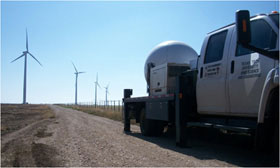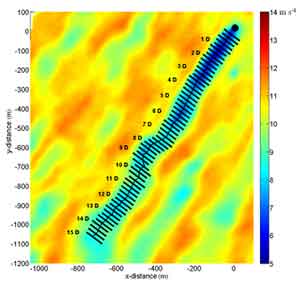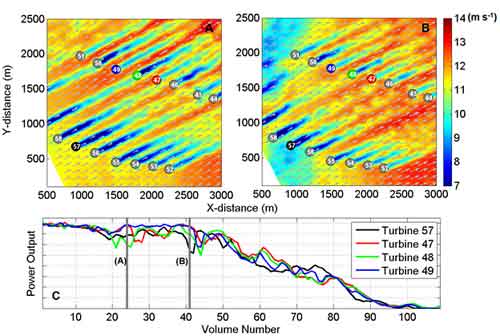Measuring the Complex Flows Found in Wind Plants
Optimizing the performance of wind plants is dependent on measuring the complex wind flows within and surrounding them, and reducing this information into practical applications and more advanced system-level control systems in order to mitigate turbine-to-turbine interaction. The TTUKa radars developed at Texas Tech University are the only technology in the world that has been proven to measure the complex flows across large sections of wind plants.

In October 2011, the National Wind Institute (NWI) made its first significant achievement using the TTUKa radar technology to instantaneously track a single utility scale turbine wake for over 30 rotor diameters downwind. Building upon this success, the team quickly collected another dataset, this time using two radar systems to fully define the horizontal wind field using dual Doppler synthesis techniques. This information not only allowed for the study of wake evolution and structure, but also provided details about the inflow conditions across the entire rotor sweep, which was later used to accurately predict power output from the turbine.
The team then patented its ideas and concepts and turned its attention to measuring the wind flow across an entire wind plant. In the summer of 2012, the team acquired several data sets from large wind arrays containing 35-70 turbines each. These initial data sets were analyzed and the team published the world's first dual Doppler analysis of the complex flows across a wind plant in 2013, which included documentation of turbine-to-turbine interaction, enhanced “wind channels” between turbine wakes, the influence of nearby terrain, transient gusts and lulls, and even array edge effects. Working with industry partners, the team was able to integrate radar measured complex flows with turbine power output data and develop an independent power curve for the wind plant. With funding from the U.S. Department of Energy, the team continued to advance the radar technology and techniques in early 2013. It then turned its attention to helping a variety of industry partners through targeted measurement and analysis campaigns wind plants across the U.S.

The use of specialized Doppler research radars to characterize wind farm flow fields represents a paradigm shift for the wind energy community. The high spatial and temporal resolutions and larger observational footprints allow for the identification of shortcomings within the current numerical simulations and modeling efforts. Integration of the operational turbine data with the radar derived wind fields provides an opportunity to investigate performance spanning individual turbines to large turbine arrays.
These capabilities provide the foundational information necessary to develop the first-generation of system level wind plant intelligence through the creation of proactive, networked control systems capable of maximizing the total power output from an entire turbine array. Such intelligence, even in a basic form, does not currently exist. Implementation of these data collection and ANALYSIS methodologies in wind farm planning, design, deployment, and operation offer the potential to revolutionize wind energy world-wide.

(A and B) Dual Doppler derived wind fields at hub height obtained from a West Texas wind farm at two different time periods. (A) High-speed (relative to the wind farm inflow) wind channels exist in between the turbine wakes. (B) A “lull” in the wind speed enters the southwest corner of the domain. (C) Turbine power output time histories for four selected turbines shows the impact of the upstream wakes, high-speed wind channels and wind speed lull.
For more information about the employed technology and techniques, or to pursue a complex flows measurement campaign with the NWI team, please contact: john.schroeder@ttu.edu.
National Wind Institute
-
Address
1009 Canton Ave., MS 3155 Lubbock, TX 79409-3155 -
Phone
National Wind Institute - 806.742.3476; Renewable Energy - 806.742.6284 -
Email
National Wind Institute - nwi@ttu.edu; Renewable Energy - windenergy@ttu.edu
